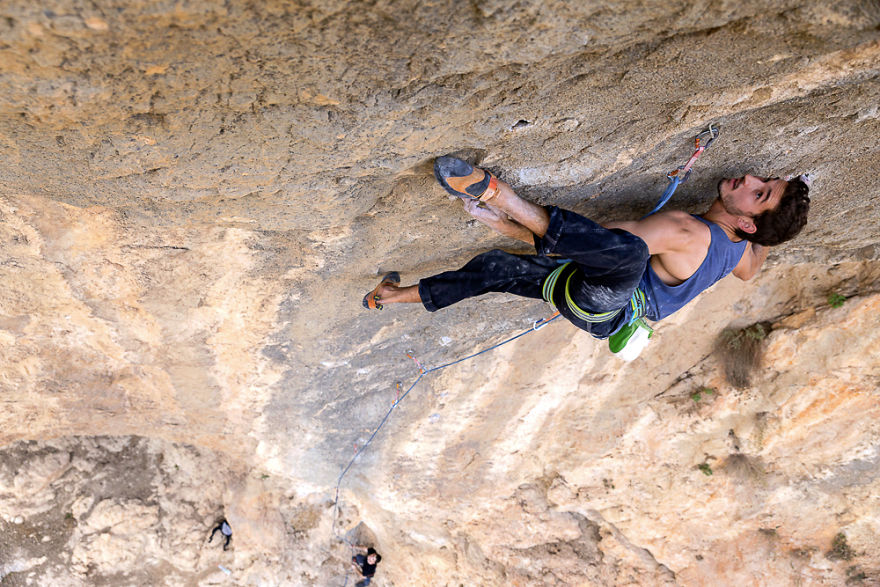
Wildlife Photographer of the Year sneak peek The Natural History Museum, London, has released 16 "sneak peek" images from this year's Wildlife Photographer of the Year competition. These highly commended images include photos from several competition categories, including Animals in their Environment, Natural Artistry, Invertebrates, Mammals, Underwater, Urban Wildlife, Photojournalism, and age-specific categories for young photographers.
Celebrating its 61st year, Wildlife Photographer of the Year is developed and produced by the Natural History Museum, London. This year's competition drew 60,636 images from photographers in 113 countries. The final categories, along with Grand Title and Young Grand Title awards, will be announced on October 14th, and will go on exhibit at the Natural History Museum starting October 17th, followed by international locations worldwide.
A tale of two coyotes
A Tale of Two Coyotes by Parham Pourahmad, USA
Highly Commended, 11 – 14 Years
Parham Pourahmad (USA) uses the morning light to frame the amber eyes
of a male coyote within the black-tipped tail of a female.
Parham followed this pair – a female and possibly her brother – for a couple of hours across the rocky hillside, quickly framing his image before the male turned to nuzzle the female. Coyotes can adapt to almost any habitat and are abundant across North America and into Central America. Once common in San Francisco, they had disappeared from the city but are now beginning to return. While they do scavenge food waste, their diet also includes rodents and other small mammals.
Location: Bernal Heights Park, California, USA
Technical details: Nikon Z8 + 180–600mm f5. 6–6. 3 lens at 600mm; 1/1250 at f6. 3; ISO 800
© Copyright Parham Pourahmad / Wildlife Photographer of the Year
Inside the pack
Inside the Pack by Amit Eshel, Israel
Highly Commended, Animal Portraits
Amit Eshel (Israel) gets eye-level with an inquisitive pack of Arctic wolves.
In temperatures of -35°C (-31°F), Amit struggled to fulfill his dream of photographing the elusive Arctic wolves of Ellesmere Island. But then, on the twelfth day of his second trip, they came closer than he had ever imagined, so close that he could smell their breath. Restricted to Canada's most northern territories and northern Greenland, Arctic wolves are curious of humans due to a lack of interaction. They're a snow-white subspecies of the grey wolf, pack animals that hunt hares and musk oxen.
Location: Ellesmere Island, Nunavut, Canada
Technical details: Canon EOS R5 + 24–105mm F4 lens; 1/1250 at F11; ISO 2000
© Copyright Amit Eshel / Wildlife Photographer of the Year
Pink pose
Pink Pose by Leana Kuster, Switzerland
Highly Commended, 15 – 17 Years
Leana Kuster (Switzerland) shows a greater flamingo in the act of scratching its head with one of its unmistakably long legs.
While on holiday in southern France, Leana had been watching flamingos in the Camargue. She was fascinated by their foraging behavior as they moved gracefully through the shallow, saline wetlands, filter feeding for molluscs and crustaceans. Flamingos use their tongues to force water through their specially adapted bills, which are lined with many rows of fine, comb-like plates. These help trap a species of brine shrimp called Artemia salina that gives the birds their famous pink hue.
Location: Pont de Gau, Camargue, France
Technical details: Nikon D810 + Tamron 150–600mm F5. 6 lens; 1/500 at F6. 3; ISO 250
© Copyright Leana Kuster / Wildlife Photographer of the Year
Rutting call
Rutting Call by Jamie Smart, UK
Highly Commended, 10 Years and Under
Jamie Smart (UK) portrays a red deer stag as it gives a mighty bellow during the autumn rut in Bradgate Park, UK.
Jamie walked up and down a path in the park at a safe distance from the stag. She stretched herself up tall to avoid any long grass in the foreground spoiling her view. The stag's antlers have regrown since their annual shedding in spring. The 'velvet' – the soft skin that covered them during their growth – has now rubbed off, exposing the bone beneath. Each new set grows larger and more complex as the stag matures, with more intricate points called tines crowning the heads of older males.
Location: Bradgate Park, Leicestershire, England, UK
Technical details: Nikon Z9 + 800mm F6. 3 lens; 1/800 at F6. 3; ISO 450
© Copyright Jamie Smart / Wildlife Photographer of the Year
Ice edge journey
Ice Edge Journey by Bertie Gregory, UK
Highly Commended, Animals in their Environment
Bertie Gregory (UK) freeze-frames the moment fledgling emperor penguin chicks walk along the edge of an ice shelf.
Bertie spent two months with the penguin colony and witnessed most chicks using ice ramps to descend to sea level for food. But this group missed the easy way down. Keeping his drone at a safe distance, he watched as they took a 15-meter (49 ft) leap into the water. Left to fend for themselves, emperor penguin chicks must find a way to make their first dip into the icy ocean to find food. Scientists believe the continued decline of sea ice in Antarctica may force more penguins to breed on ice shelves, making this behavior increasingly common in the future.
Location: Ekstr
Technical details: DJI Mavic 3 Pro + Hasselblad L2D-20c 24mm F2. 8 lens; 1/50 at F3. 5; ISO 100
© Copyright Bertie Gregory / Wildlife Photographer of the Year
Deadly lessons
2025-9-8 15:00

